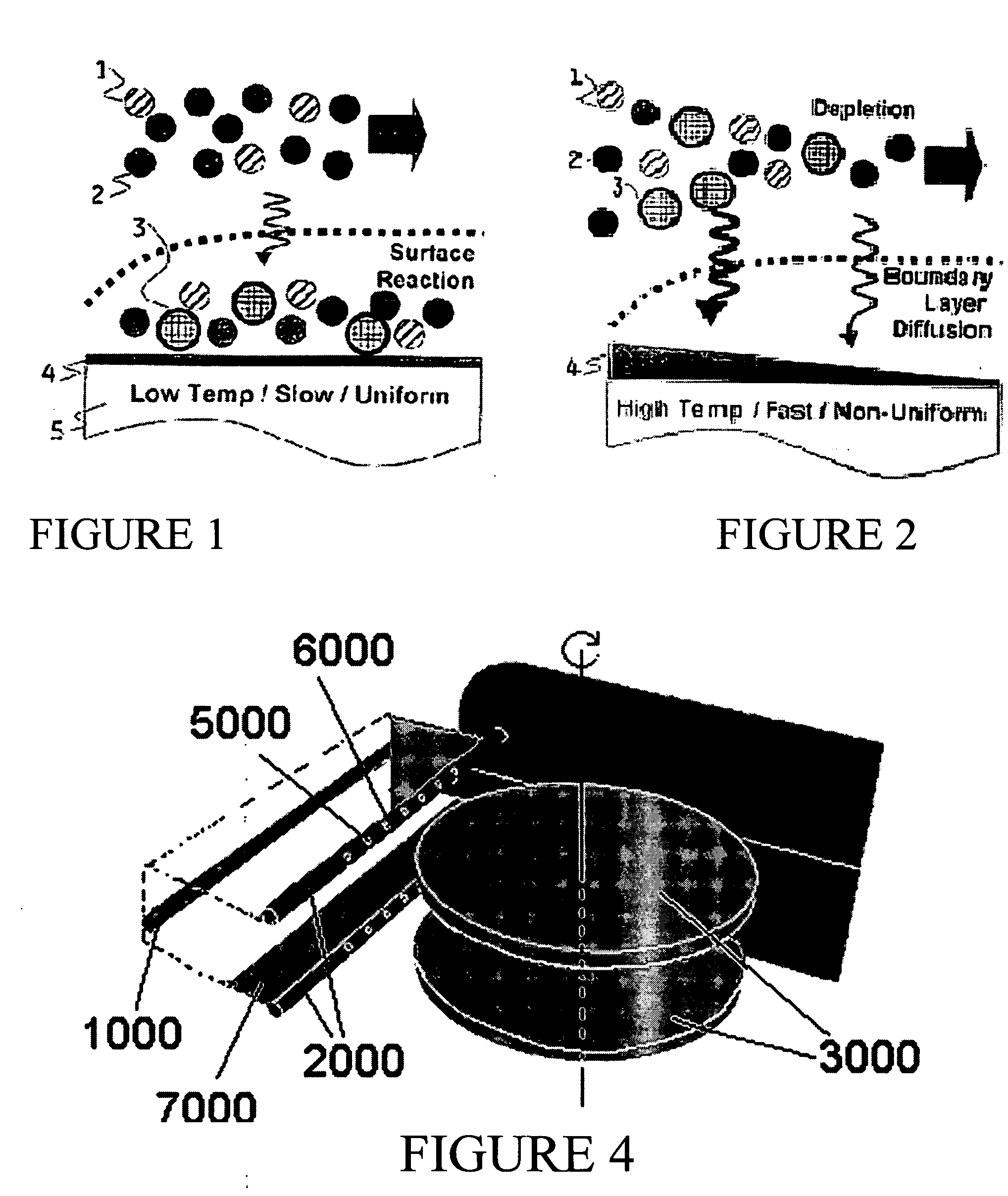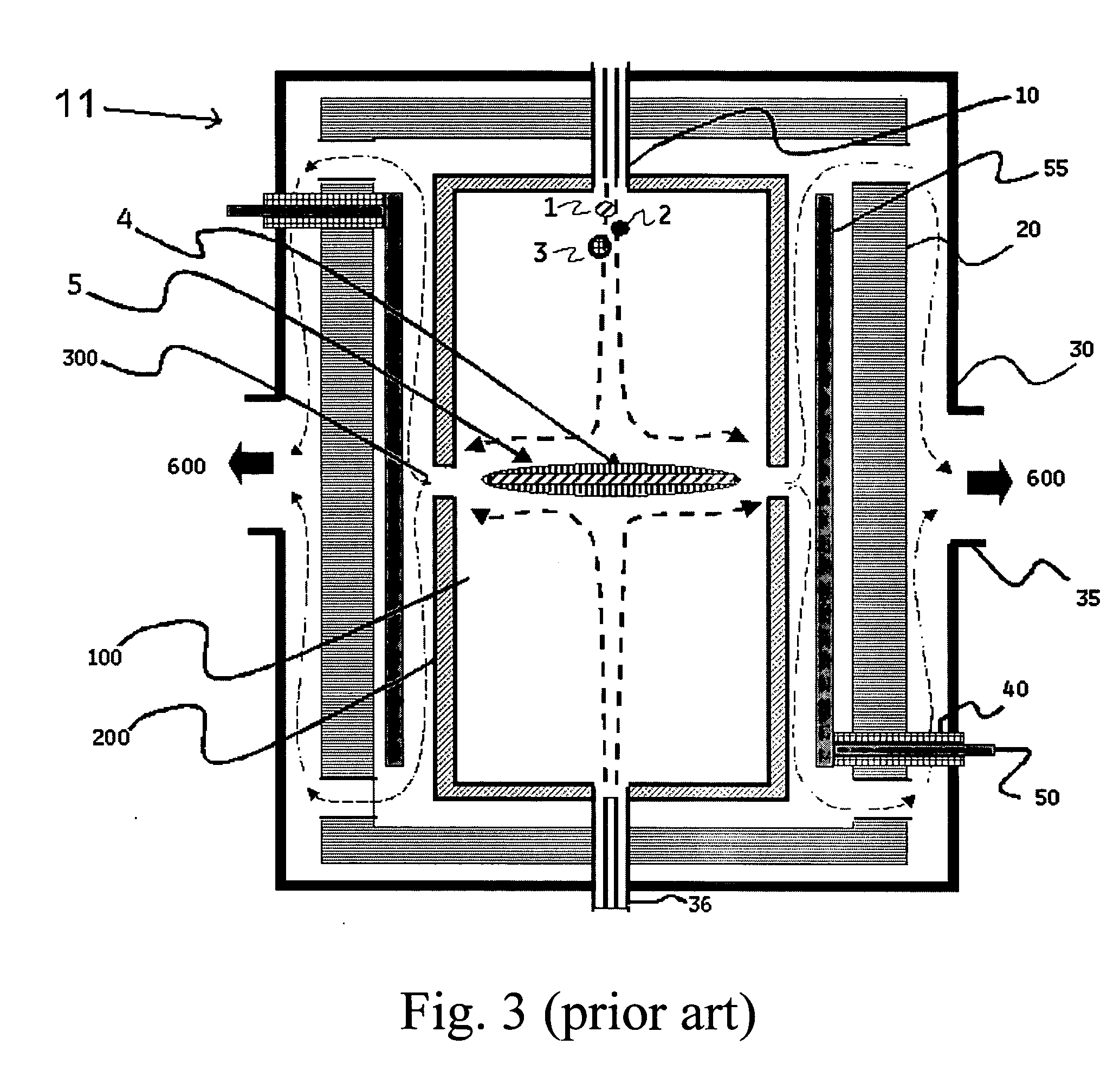High temperature chemical vapor deposition apparatus
a chemical vapor deposition and high temperature technology, applied in chemical vapor deposition coatings, coatings, metallic material coating processes, etc., can solve the problems of chemical non-uniformity, thickness and chemistry non-uniformity, etc., to maximize precursor flow and maximize dopant deposition
- Summary
- Abstract
- Description
- Claims
- Application Information
AI Technical Summary
Benefits of technology
Problems solved by technology
Method used
Image
Examples
example 1
[0089] In an illustrative example of a process to deposit layers in various configurations of the CVD apparatus of the invention, the heated inner walls of the chamber 11 is first heated to 1800° C. The pressure in the exhaust line is controlled to a pressure in the 300 to 450 m Torr range. Gaseous feed CH4 and N2 are supplied at 5 slm and 2 slm respectively through the first injector 1000. BCl3, NH3 and N2 are supplied at 2 slm, 5.5 slm and 3 slm respectively through a set of two secondary injectors 2000. The feeds are mixed prior to enter the inlet of the injector pipes.
[0090] The injector are graphite pipes having a length of 63 cm, a diameter of 1″, with a plurality of feed holes each 1 cm in diameter, and placed apart at 2″ on 2000 and 1″ on 1000. The leading edge of substrate 3000 having a 450 mm diameter is located at a distance of 2″ from the secondary injectors. The first injector is spaced at further away from the secondary injectors 2000, providing enough residence time ...
example 2
[0096] In this example, the sensitivity of the resistance characteristics of the film is studied with the flow rates of the C dopant (as CH4 feed) in injector system 1000 varying from 3 slm to 7 slm. It is found that increasing the CH4 flow rate increases the C precursor concentration near the substrate, which in turn, increasing the C % in the film and hence the average resistance of the film decreases with the concentration. Also, it is found that the resistance ratio (max. / min) increases with the flow rates. Therefore, the dopant CH4 flow rate—as fed through the injector system 1000 being placed further away from the substrate, is an effective design parameter which gives a good control on the C deposition on the substrate, and subsequently, the resistance characteristics of the coated film.
[0097]FIG. 11 illustrates the sensitivity of resistance of the CPBN film on the substrate to the flow rate of CH4 from the first injector system. FIG. 12 is a graph illustrating the resistanc...
example 3
[0098] In another illustrative example, a detailed set of design of experiments (DOE) was carried out with the two design factors in Example 1. In this example, a CPBN film on the substrate is desired, which has resistance characteristics as described in FIG. 11. The C percentage in the film is related to the resistivity as in FIG. 10. This resistivity and the film thickness can be used to estimate the resistance of the film on the substrate. These calculations are summarized as in FIG. 12. A parametric analysis is carried out to study the effect of two parameters of the apparatus—the distance between the substrates and lead distance of the first injector from the substrate—on the resistance characteristics of the deposited film. These two parameters have strong influence on the resistance of the deposited film as seen from the minimum and maximum resistances on the substrate.
PUM
| Property | Measurement | Unit |
|---|---|---|
| pressure | aaaaa | aaaaa |
| temperature | aaaaa | aaaaa |
| temperatures | aaaaa | aaaaa |
Abstract
Description
Claims
Application Information
 Login to View More
Login to View More - R&D
- Intellectual Property
- Life Sciences
- Materials
- Tech Scout
- Unparalleled Data Quality
- Higher Quality Content
- 60% Fewer Hallucinations
Browse by: Latest US Patents, China's latest patents, Technical Efficacy Thesaurus, Application Domain, Technology Topic, Popular Technical Reports.
© 2025 PatSnap. All rights reserved.Legal|Privacy policy|Modern Slavery Act Transparency Statement|Sitemap|About US| Contact US: help@patsnap.com



